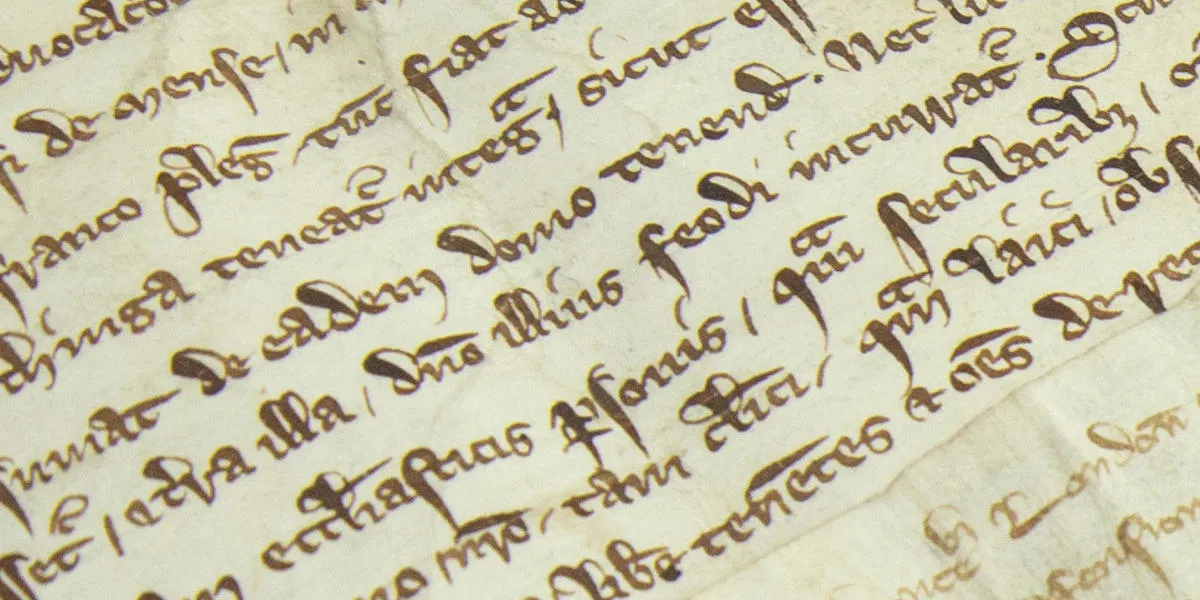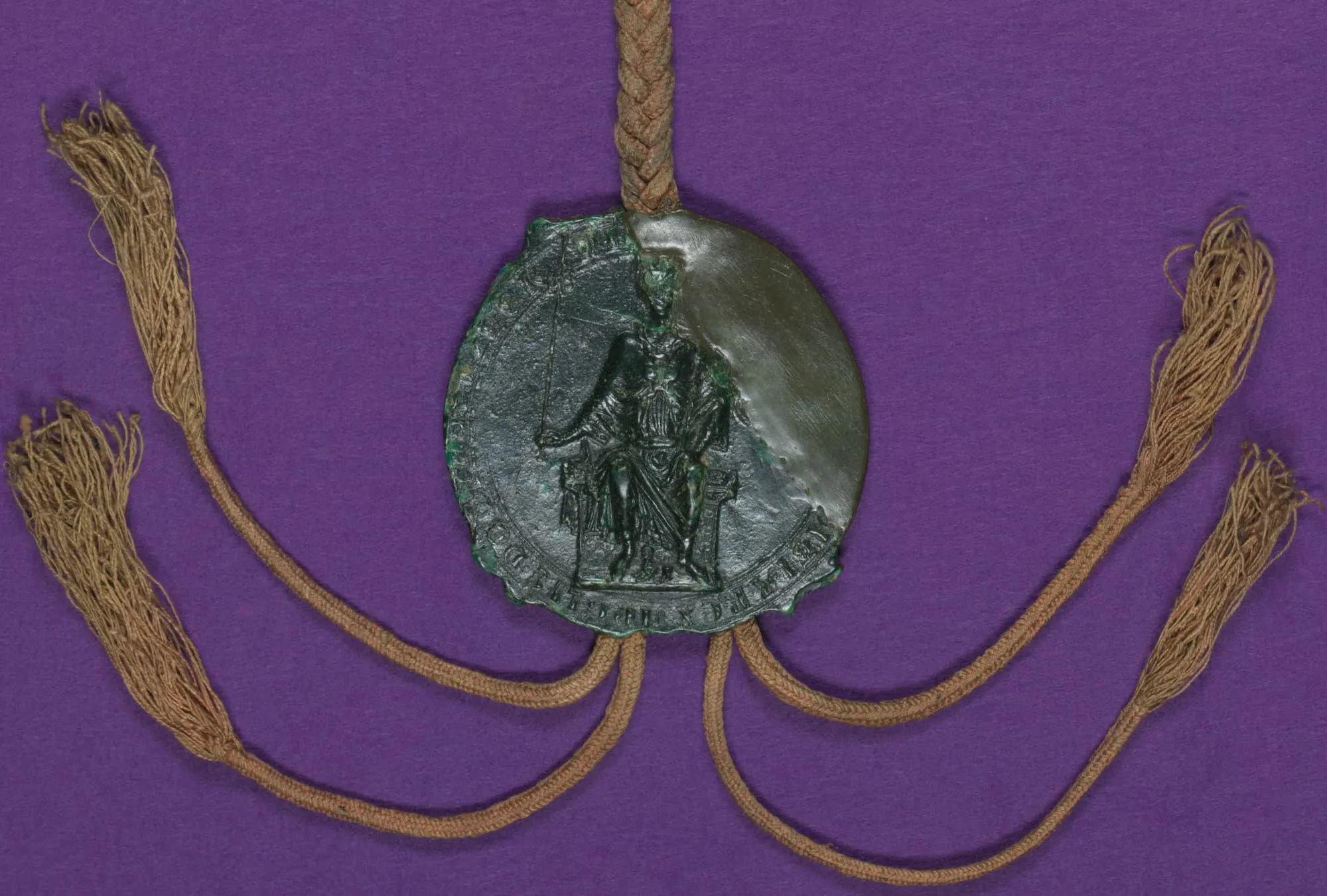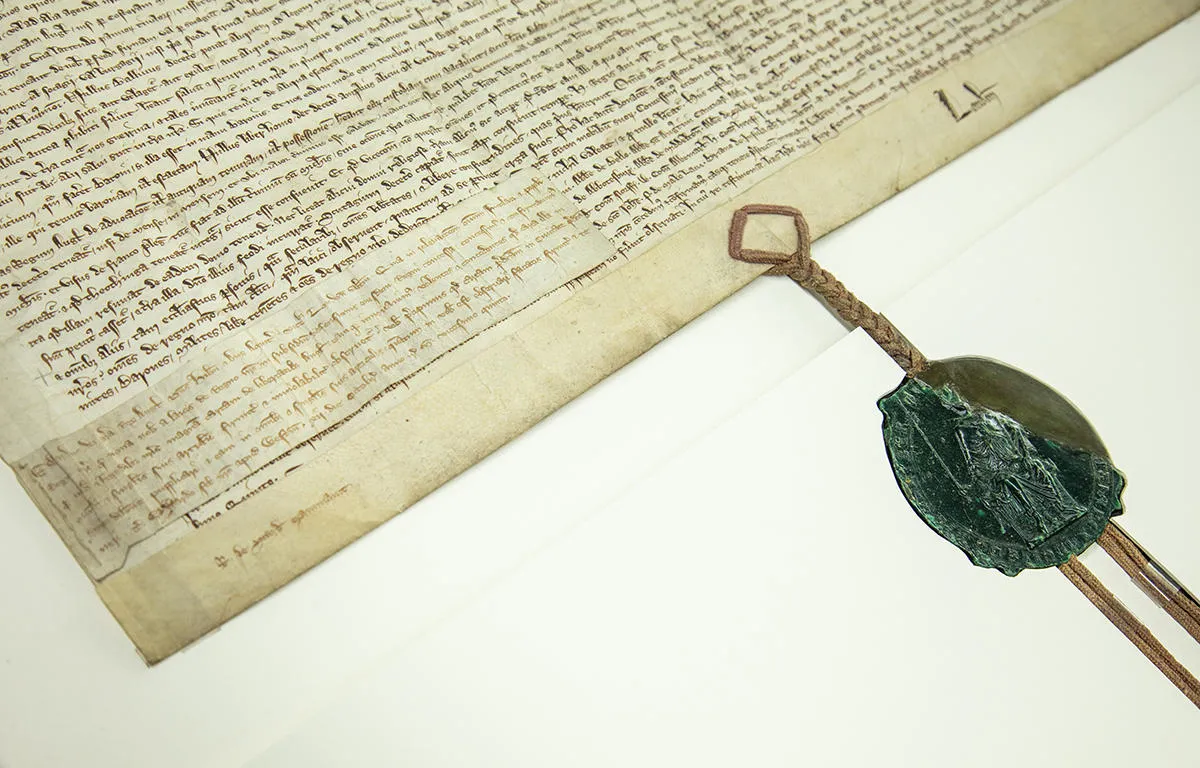Magna Carta in the City of London

Magna Carta is one of the most famous documents in English history, and the granting of a charter by King John at Runnymede has an almost mythical status.
Magna Carta has been invoked at various points in British history – such as during the English Civil War – and it was a foundational document in the creation of the American Constitution. The 1215 charter was reissued and confirmed several times in the thirteenth century and the City of London’s 1297 charter is one of these.
The City of London’s Magna Carta was displayed at The London Archives in September and October 2024. Find out more as we answer commonly asked questions!
What does Magna Carta mean?
Magna Carta means Great Charter, but it wasn’t always called that.
- Initially referred to as the Statute of Liberties, charter of liberties (carta libertatum), or Charter of Runnymede; not the first of its kind - such statutes were quite commonly issued in those times by freshly-crowned kings (William I in 1067, Henry I in 1100)
- The term ‘maior carta’ or ‘magna carta libertatum’ first meant literally ‘a big charter’ and related to its size after forest clauses are taken out and developed into a physically smaller Charter of the Forest in 1217
- Only when Magna Carta was reissued in its final shape in 1225 by Henry III; he referred to it in a letter to the bishop of Durham, as ‘magna;’ in the sense of ‘great’, indicating its importance; it has remained so ever since
- Letters patent confirming King Henry III’s confirmation of Magna Carta: Letters patent are a published written order issued by a monarch, president or other head of state, generally granting an office, right, monopoly, title or status to a person or corporation. This – issued by Edward I in 1297, confirming his father Henry III’s confirmation of the Magna Carta
Video about Magna Carta

Is this the original Magna Carta?
It dates from 1297, not 1215. It’s not one of the first copies, but it is original in the sense that it was issued by the royal chancery and sealed with the royal seal.
What people usually mean by original is the 1215 version, but even that’s not straightforward. If by 'original magna carta' you mean a single original document 'signed' or 'sealed' personally by King John in 1215 in Runnymede, it never existed.

Historical background
It was granted on 15 June 1215 in Runnymede, a meadow on the banks of the Thames, where the king’s party and the baron and bishops’ party, fed up with injustices, failures and mismanagement, meet. Barons were the top level in feudal hierarchy and held land directly from the king.
Their grievances were well justified. Between 1199 and 1215 John managed to:
- lose Normandy and other French lands inherited by his mother Eleanor of Aquitaine in very costly wars (to Philip II of France). To fund these, he repeatedly imposed arbitrary and extortionate taxes on his barons who had just lost their French lands and with them, most of their income.
- get excommunicated (together with the rest of the country) by the Pope. Meaning no church services, no burials, marriages, baptisms – a shocking concept to the medieval mind, an unbaptised person goes to hell. To make up John eventually makes peace with the Pope by offering him England as his fiefdom, the Pope becomes officially England’s feudal overlord and receives annual tribute of 600 pounds). It continues in theory until Henry VIII’s break with Rome, in practice till 1290s.
- become known for his tendency to use arbitrary imprisonment, usually of wives and children of barons who owed him money; and extreme vindictiveness and cruelty even by medieval standards (William de Braose and his family).
The marshy ground, not great for horses and other heavy equipment, was selected to avoid an ambush. Barons and bishops present the king with a list of demands known as 'Articles of the Barons', which mostly address the king’s abuses of feudal custom: justice, taxes, local government, towns and trade, appointments and patronage, redress of past grievances, use of forests and rivers, the treatment of the Welsh and the Scots, and so on.
On 15 June 2015 King John unwillingly agreed.
How many 1215 copies were made?
Several versions of the charter were made. We know that because there’s a chancery writ ordering copies to be sent to sheriffs and bishops, and there were about 40 or 50 of them. Written up by various local scriptoria, not all in royal chancery, different sizes, different scripts. Four 1215 versions survive and two are held at the British Library, and one each at Salisbury and Lincoln.
But the 1215 Magna Carta was very short-lived. Soon after granting, John got it annulled by the Pope Innocent – not least because Magna Carta states that if the king breaks the terms, he and his family can be seized and imprisoned. It was accompanied by a list of enforcers who could legally, according to its terms, seize and imprison the king if he broke the terms (one of them was the Mayor of London, William Harding, but not mentioned by name). Although monarchs were granting charters before then, and could stick to their terms or not, this gave Magna Carta real power to make sure it is not ignored.
Why is the City of London's copy so special?
The City of London Corporation owns two copies of Magna Carta – 1297 and 1300, which was the final reissue, also by Edward I. They are catalogued as letters patent or inspeximus; there is also a copy with decorated initial 'E' written into Liber Horn of 1311 (custumal 2, f. 21r).
Seal and writ. The 1297 copy is special as it has an almost complete original pendant seal attached to the document with a silk cord, and a ‘writ’ cover letter appended to it at the bottom (stitched on), which urges the sheriffs to publish (announce), keep and observe the articles. The seal is one of the best preserved seals on any Magna Carta versions. It is Edward I’s ‘seal of absence’, not his great seal, as he was in Flanders when Magna Carta was issued; it is smaller and less flashy than the great seal (which would have been appended to the 1300 version).
City of London. Both 1215 version (clause 13) and subsequent versions mention City of London by name, where it confirms its ancient liberties and customs, granted also to other cities and towns.
It is one of the best preserved copies in existence. Originally, it would have been folded into a small rectangle (the fold marks are still visible), with the seal, probably in a silk seal bag, kept inside its folds. At the back, it is inscribed (endorsed) magna carta r[egis[ H[enrici] de libertatibus Angl[ie] confirmata per dominus r[egem] E[dwardum] etc. This would have been visible when folded. The Magna Carta was kept at the Guildhall, and during the Second World War, in the vaults of the Bank of England for protection. We don’t know when it was unfolded.
Is the City of London's copy the only 1297 version?
No. We know of about more than a dozen surviving copies of Edward I’s Magna Carta (1297 and 1300 – final reissue). One is in Australia, one in USA – the only two Magna Cartas abroad.
What is it written on?
Parchment – animal skin, which was commonly used for official documents in the Middle Ages. Also sometimes referred to as vellum, although strictly speaking parchment is made from sheep skin and vellum from calf skin.
Because if its durability, vellum was used for printing record copies of public acts until 2015. In 2016 the House of Commons decided to print them on archival paper, with vellum cover, to save money.
What language is it written in?
Medieval Latin, which was used for official administrative documents in the UK until 1733.
Administrative Latin is also heavily abbreviated, with standardised abbreviations used by scribes. This was due to the speed of writing and to save the expensive parchment. Extremely efficient but also tricky to read, even if you know Classical Latin.
Script: Anglicana (also known as charter hand, court hand, or cursiva antiquior).

Why are only three clauses still valid?
Out of 63 original clauses, only three clauses are still on the UK Statute books, therefore legally binding. Can you see the numbers? No - neither the 1215 version nor any other were numbered: the numbering was done by the renowned legal scholar and constitutional lawyer Sir William Blackstone, who prepared the first critical edition of Magna Carta in 1759.
Three valid clauses (1215 numbering):
- 1. Church of England - The English Church shall be free, and shall have its rights undiminished, and its liberties unimpaired.
- 13 (9): City of London – marked by the note on the margin The city of London shall enjoy all its ancient liberties and free customs, both by land and by water. We also will and grant that all other cities, boroughs, towns and ports shall enjoy all their liberties and customs.
- 39/40 (29): Imprisonment and liberty – the Golden Passage, Clauses 39 and 40 of the 1215 version: ‘No free man shall be … imprisoned … except by the lawful judgment of his equals or by the law of the land. To no one will we sell, to no one deny or delay right or justice’.
The rest isn’t there because:
- some clauses were repealed because they were no longer relevant (feudal law);
- others are definitely still relevant, but became redundant as their contents were covered by later legislation. From 1820s, trend arose, inspired by Napoleon, to codify English laws which were a jumble of common law, precedent and unofficial statute books, often confused and contradictory; nine volumes of Statutes of the Realm published between 1810 and 1825 by the Record Commission. Magna Carta fell victim despite its mythical status by then – time of critical thinking, challenging the ‘immutable texts’, Darwin etc.
The legacy of Magna Carta
Magna Carta started as a very practical document aimed at addressing very practical grievances of the top classes of medieval society. It certainly didn’t advocate equality and human rights for all. Socially it’s very conservative, guarding the rights of the male elite and completely ignoring the 90% of unfree people. Women – nice that it forbids the monarch to force widows to marry against their will, but it also states that ‘no man shall be taken or imprisoned upon the appeal of a woman, for the death of any other than her husband’. However, that one clause about imprisonment made it transcend its original purpose. It became the inspiration for freedom movements all around the world: Bill of Rights 1689, US Bill of Rights 1791, and the Universal Declaration of Human Rights 1948.
Often misunderstood, misquoted, and misused, a document much quoted but rarely read. The best way to understand it is to read it – a transcript of the Latin text together with translation is available on the the Online Library of Liberty.
Magna Carta translation